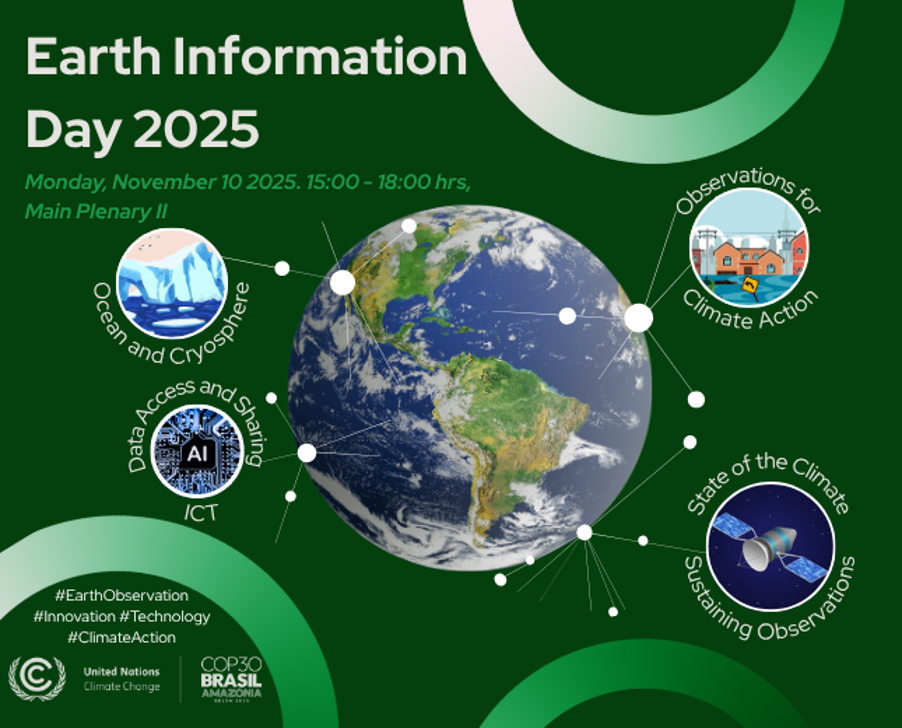At COP30, growing demand for Earth observations needs to be in the spotlight

As policymakers begin discussions in Belém at this year’s UN Climate Conference (COP30), one important conversation that needs to happen is about how to meet the growing demand for Earth observation technologies that can support the world’s climate plans. For the Group on Earth Observations (GEO) community, this is our call to action.
Nationally Determined Contributions (NDCs) are actions countries submit to the UN Climate Change secretariat outlining how they intend to cut greenhouse gases and adapt to climate change under the Paris Agreement. They’re central to global climate action and are expected to receive major attention at COP30.
A new UNFCCC NDC Synthesis Report shows an unmistakable trend: governments are asking not just for finance and capacity, but for data, monitoring and geospatial solutions to make their goals work.
- On adaptation, “All Parties… considered how to improve adaptation-relevant research, data, information and monitoring, and ensure that adaptation efforts are informed by science, for example through data-collection programmes, national databases on impacts, monitoring systems, observation networks...” (p. 32, para. 136).
- On oceans, “78 per cent of Parties” included “at least one explicit reference to the ocean – an increase of 39 per cent,” compared with the previous NDCs (p. 6, para. 9). And “30 per cent… highlighted capacity-building needs… for strengthening data collection for ocean observation and monitoring systems” (p. 28).
- On technology and innovation, the signal is even stronger. The report notes that “for adaptation,... a majority of Parties (more than 50 per cent) referred to technology measures related to climate monitoring and observations… often combined with geospatial tools and digital solutions, including use of artificial intelligence” (p. 7, para. 13), “increased from 22 to 55 per cent since previous NDCs” (p. 49, paras. 193–194). The share of Parties (73 per cent) that referred to measures related to technology innovation, research and demonstration for achieving their climate targets has more than doubled since their previous NDCs. (p. 7, para. 13)
That’s a clear and documented global policy demand for Earth Intelligence and the kind of services GEO delivers.
From policy to practice: turning evidence into action
The GEO community is already responding. Through initiatives such as GEO Blue Planet and the launch of NAP Supplementary Guidelines on coastal and ocean adaptation with a call for pilot partners in SIDS and LDCs, GEO is helping countries turn Earth observation data into practical tools for adaptation and resilience planning.
And in Belém, that message takes the stage.

Credit: UNFCCC; watch the webcast watch the webcast at 15:00-18:00 BRT/UTC-3 on 10 November.
As part of Earth Information Day 2025 on 10 November, GEO will deliver a joint presentation with the Coordination Group for Meteorological Satellites, the Committee on Earth Observation Satellites (CEOS) and the Systematic Observations Financing Facility (SOFF).
Representing CEOS and GEO, ECMWF Director-General Florence Rabier will talk alongside SOFF Secretariat Director Marcus Repnik about “Advances in sustaining systematic observations and scalable related innovations”.
Then, during a breakout session, Digital Earth Pacific will be represented by Coral Pasisi, Director of Climate Change and Sustainability for the Pacific Community, who will present on “Earth observations for the assessment of economic and non-economic losses,” responding to the growing focus on ocean and coastal systems so many NDCs now emphasise.
New NDCs show what the world needs: sustained observations, shared data and the innovation to scale. At COP30, those building blocks will be in the spotlight.